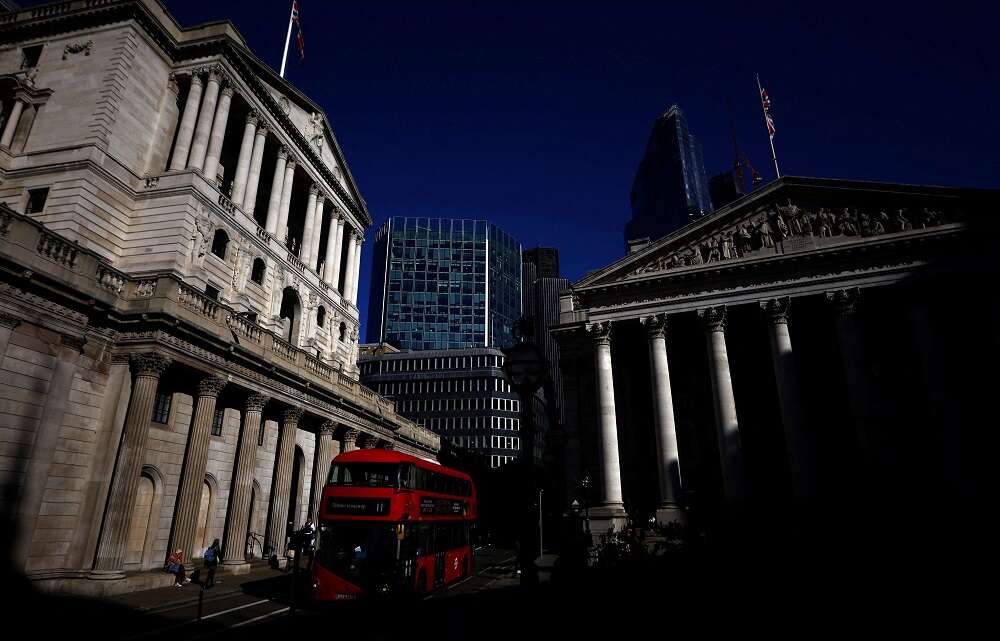
LONDON (Reuters) – The Bank of England again sought to stem a sharp sell-off in Britain’s 2.1 trillion pound ($2.3 trillion) government bond markets on Tuesday, expanding its emergency buying to inflation-linked debt.
The slump in government bond prices – and the subsequent surge in yields – has threatened to wreak havoc in the country’s pension industry, hurt the housing market and increase the recession risks for the broader economy.
Following is a summary of key questions raised by the upheaval in financial markets.
WHY IS BRITAIN FACING ANOTHER FINANCIAL CRISIS?
Investors were already worried about the huge cost of the tax cuts and energy subsidies promised by new Prime Minister Liz Truss even before Finance Minister Kwasi Kwarteng announced more cuts to taxes late last month.
Rather than heed Kwarteng’s promises of stronger economic growth, investors took fright at the prospect of higher inflation caused by unfunded fiscal policy – which they saw as forcing the Bank of England to speed up its interest rate increases.
Sterling slid against the U.S. dollar, adding to inflation pressure in a country that relies on imports for its fuel, food and other products. Even more worryingly for the BoE, yields on government bonds leapt, especially on long-term debt, causing problems in Britain’s pensions industry.
WHY IS THE BANK OF ENGLAND BUYING BONDS AGAIN?
By buying bonds, the BoE is seeking to reverse what it sees as “dysfunction” in the bond market. Specifically, the central bank was seeking to address problems facing pension funds.
They were forced to stump up vast amounts of emergency collateral in liability-driven investments (LDI), which use derivatives to hedge against shortfalls in pension pots, after British government bonds dropped sharply in value.
Many did so by selling gilts, sparking a vicious cycle of falling prices that forced the BoE to pledge to buy as much as 65 billion pounds of long-dated conventional government bonds between Sept. 28 and Oct. 14.
While this intervention bolstered that particular section of the gilt market, this week a fire-sale of inflation-linked gilts – which are pegged to changes in consumer prices – took place in similar circumstances.
A day later, the BoE announced it would also buy these bonds.
Until the end of this week, the BoE will now spend up to 10 billion pounds a day buying gilts: half allocated to linkers, and the other half to long-dated standard bonds.
By temporarily acting as a buyer for the bonds, the BoE aims to prevent panic selling and give pension funds time to sort out their liquidity problems.
The buying programme is different to the one the BoE launched during the 2020 COVID-19 pandemic, after the Brexit referendum and following the 2008-09 financial crisis, as it is only designed to be very short term.
Investors are nervous about the prospects for gilts after Friday and a pension industry body has urged the BoE to extend its support to the end of this month.
WHAT CAN TRUSS AND KWARTENG DO NOW?
Investors are waiting for Kwarteng to explain his fiscal plans and publish new forecasts from the Office for Budget Responsibility on Oct. 31 – but turmoil in markets could force more action from either the BoE or government in the meantime.
Truss promised to smash the economic “orthodoxy” in her bid to become leader of the Conservative Party and Kwarteng’s tax cut announcements represented a doubling down on the pledges she made during the campaign.
Downing Street says there will be more announcements of reforms to improve the growth potential of Britain’s economy – which are likely to involve attempts at cutting back planning rules, changes to the immigration system and more investment in training and infrastructure.
WHAT DOES ALL THIS MEAN FOR THE HOUSING MARKET?
Mortgage lenders have scrambled to keep up with wild swings in the sterling funding markets that determine the mortgage rates they offer to homeowners.
Some lenders temporarily stopped issuing mortgages to new customers and others ramped up repayment rates for new loans to levels likely to stretch millions of existing homeowners and make new mortgages unaffordable for many others.
Mortgage deals for new customers now feature rates at around 5%-6% – a steep increase from the norm of around 2% for the last five years which is prompting rising concern of a collapse in the property market further down the line.
(Writing by William Schomberg, David Milliken and Andy Bruce; editing by David Evans)


